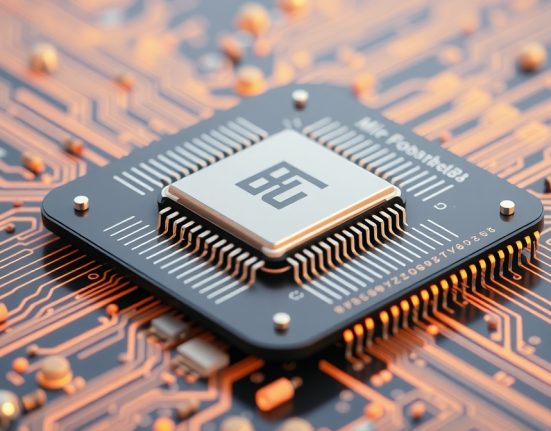Introduction
In the last decade, the electronics world has experienced a genuine revolution with the development of flexible and wearable electronics technologies. Unlike traditional electronic components built on rigid substrates such as silicon, flexible electronics enables the creation of electronic circuits on flexible, thin, and lightweight materials that can be integrated into a wide range of products and applications. This advancement allows better integration with the human body and leads to innovative developments in healthcare, sports, security, and entertainment.
This article will review the most advanced materials and technologies that form the basis of the flexible and wearable electronics revolution, focusing on the most recent developments as of 2025.
Advanced Materials in Flexible Electronics
Conductive Polymers
Conductive polymers constitute one of the central foundations for flexible electronics. Significant developments have occurred in this field in recent years:
PEDOT:PSS (Poly(3,4-ethylenedioxythiophene):polystyrene sulfonate) – This polymer has significantly improved its electrical conductivity in recent years, reaching values of over 7,000 S/cm, approaching the conductivity of certain metals. New processing techniques developed in 2023-2024 allow for a combination of higher mechanical stability alongside improved conductivity.
Elastomeric conductive polymers – New polymeric compounds have been developed that can stretch up to 5 times their original length while maintaining their electrical conductivity, enabling new applications in stretchable sensors and dynamic electronic circuits.
Nanomaterials
Nanomaterials play a central role in the development of flexible electronic components:
Carbon nanotubes (CNTs) – New separation and orientation techniques developed in leading laboratories in 2024 enable the creation of nanotube networks with conductivity three times higher than the previous generation, with improved stability even under sustained mechanical deformation.
Graphene and its derivatives – Progress in mass production methods for high-quality graphene has led to the development of particularly transparent and flexible electrodes used in flexible displays and solar panels. The latest development in the field is functional graphene whose electrical properties can be tailored according to application requirements.
Silver nanowires – Networks of silver nanowires have become a significant alternative to indium tin oxide (ITO) in transparent electrodes. New production methods from 2023 allow these networks to be produced with low resistance, high transparency, and excellent flexibility.
Self-Healing Materials
One of the most exciting developments in 2024 is the development of materials with “self-healing” capabilities:
Conductive hydrogels – New hydrogels have been developed that can spontaneously heal themselves after a cut or tear while maintaining electrical conductivity. This capability significantly extends product life and improves reliability under harsh usage conditions.
Elastomers with dynamic bonds – These materials combine electrical conductivity with the ability to restore themselves at relatively low temperatures (40-60°C), allowing for quick repair of damaged wearable electronic devices.
Advanced Manufacturing Technologies
Electronic Printing
Printing technologies constitute one of the central tools in the production of flexible electronics:
Electronic inkjet printing – Progress in printing precision has reached a resolution of less than 10 microns, enabling the creation of complex circuits on a wide range of flexible substrates. This precision allows for the production of smaller transistors with improved performance.
Aerosol-jet printing – This technology has developed significantly and allows printing on three-dimensional and non-flat surfaces, opening new possibilities in integrating electronics onto products with complex shapes.
Roll-to-Roll printing – This method has allowed for a significant increase in production rate while maintaining low costs. Improvements in the process now allow for the sequential integration of several different functional layers in the same production process.
Sealing and Encapsulation Processes
Protecting flexible electronic components from moisture, oxygen, and other environmental factors is a significant challenge:
Composite sealing materials – New sealing layers have been developed that combine polymers with nanoparticles, providing improved protection against water and oxygen penetration while maintaining the flexibility of the device.
Atomic Layer Deposition (ALD) methods – Atomic layer deposition methods have been improved to work at low temperatures, allowing application on heat-sensitive polymeric substrates.
Advanced Flexible Components
Flexible Transistors
Organic TFT transistors – A new generation of organic thin-film transistors (OTFT) exhibits charge carrier mobility of over 15 cm²/Vs, allowing for faster and more energy-efficient circuits.
Metal oxide-based transistors – New metal oxides have been developed that can be processed at low temperatures, enabling the creation of high-performance transistors on polymeric substrates.
Flexible Sensors
Pressure and stretch sensors – New sensors can detect gentle touch and pressure with sensitivity ten times higher than the previous generation, while maintaining reliable operation even after thousands of stretching cycles.
Biochemical sensors – New platforms have been developed for continuous monitoring of physiological parameters through sweat, including glucose levels, electrolytes, and biological stress indicators, with accuracy approaching that of traditional blood tests.
Flexible Energy Sources
Organic solar cells – Energy conversion efficiency in organic and flexible solar cells reached approximately 18% in 2024, representing a dramatic improvement and enabling their integration as an independent energy source in a variety of wearable devices.
Flexible batteries and supercapacitors – New structures of batteries and supercapacitors have been developed that can stretch up to 300% of their original length without performance degradation, with significant improvement in energy density.
Triboelectric energy harvesting devices – New devices have been developed that can collect energy from body movements and convert it to electricity with efficiency twice as high as the previous generation, enabling independent operation of wearable devices over time.
Advanced Applications
Health and Medicine
Continuous medical monitoring systems – New wearable systems allow continuous monitoring of vital signs for weeks without battery replacement, while transmitting data in real-time to smart healthcare systems.
Localized treatment – Smart electronic patches that combine sensing of biological markers with controlled drug release, enabling personalized and precise treatment.
Rehabilitation and movement assistance – Flexible and lightweight exoskeletons, combining sensors and electrical actuators, provide personalized support for motor rehabilitation and movement assistance.
Sports and Fitness
Smart clothing – Sports clothing that incorporates flexible sensor arrays integrated into the fabric, providing detailed analysis of movement, physiology, and sports performance.
Real-time feedback systems – Systems have been developed that provide immediate feedback through vibration or gentle electrical stimulation to correct movements and prevent injuries.
Consumer Electronics
Flexible and stretchable displays – Flexible OLED technologies have reached commercial maturity, with displays capable of folding hundreds of thousands of times without loss of display quality.
Flexible keyboards and user interfaces – Touch interfaces have been developed that incorporate advanced tactile feedback, enabling a more natural user experience with flexible devices.
Smart Textiles
Functional fabrics – New weaving and knitting techniques allow the integration of electronic threads into fabrics, creating textiles with wireless communication capabilities, environmental sensing, and even color or temperature change according to environmental conditions.
Energy-generating textiles – Fabrics have been developed that can generate electricity from sunlight or body movement, using integrated piezoelectric or photovoltaic fibers.
Challenges and Future Trends
Current Challenges
Mass production processes – Despite significant progress, there is still a challenge in transferring technologies from the laboratory to mass production at competitive costs.
Reliability issues – Improving the long-term durability of flexible electronic devices, especially under harsh usage conditions (humidity, heat, mechanical wear), continues to be a challenge.
Data security and privacy – As wearable devices collect more personal and medical information, data security and privacy issues become more significant.
Future Trends
Integration with artificial intelligence – Integration of energy-efficient AI algorithms in wearable devices, enabling local data processing and autonomous decision-making.
Integration with the human body – Progress towards bio-integrated electronics that can communicate directly with biological systems.
Transition to biodegradable and environmentally friendly materials – Development of flexible electronics platforms based on biological and biodegradable materials, reducing environmental impact.
Conclusion
Flexible and wearable electronics are undergoing a period of flourishing and accelerated development, driven by innovation in materials, manufacturing technologies, and system design. Recent developments in the field enable the creation of devices with improved performance, higher reliability, and new application possibilities. While significant challenges still exist, especially in terms of mass production, long-term durability, and data security, the rapid pace of innovation in the field promises additional breakthroughs in the coming years. The increasing integration between flexible electronics, artificial intelligence, and biological systems is expected to open new and exciting possibilities that will shape the future of wearable technology and human-machine interaction.













